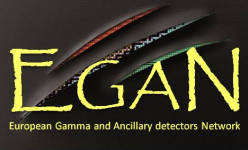Speaker
Jan Mierzejewski
(Heavy Ion Laboratory, University of Warsaw)
Description
The 20Ne+122Sn reaction was studied with the EAGLE [1] spectrometer, consisting of 12 Ge detectors and 30 elements Si-ball. The reaction mechanism was analyzed by an angular distribution of alpha particles, gated by gamma transitions characteristic for final reaction products. The data from our experiment, as well as 12C+160Gd [2] and 12C+51V [3] reactions, were interpreted in terms of a new model describing the dynamics of the Incomplete fusion reaction (ICF). Our model is a development of Sum Rule Model [4]. It is based on an assumption, that incomplete fusion is a two stage process. In the first stage, the projectile breaks apart before colliding with the target. In the second stage the projectile residue fuses with the target while the rest escapes in some effective potential. The escaping („projectile like”) fragment is emitted in forward angles, usually observed at θ<60 degrees in laboratory frame. ICF influence on high spin states population was shown [5], nevertheless so far proposed models don't handle the dynamics of the process - the creation of the compound nuclei and a „projectile like” fragment emission. Recently γ-ray fold distributions measured with the γ-detector array GASP [6], have been compared to the predictions of our model. We would like to briefly present the basics of the model as well as its software implementation – the COMPA code. It works in event by event mode, gives a complete information on the reaction products: spin and excitation energy of the recoil, reaction point coordinates, directions and velocities of the recoil and emitted light particles. The stopping of the reaction products in the passive elements of the setup, like support, target and backing, is taken into account. This way COMPA allows easy comparison with the experimental results. Bibliography [1] - J. Mierzejewski et al. submitted to Nucl. Instr. and Meth. A [2] - K. Siwek-Wilczyńska et al. Phys. Rev. Lett. 42, 1599(1979) [3] - D. J. Parker et al. Phys. Rev. C30, 143(1984) [4] - J. Wilczyński et al. Phys. Rev. Lett 45, 606 (1980) [5] - Pushpendra P. Singh et al. Phys. Rev. C 80, 064603 (2009) [6] - R.M. Lieder et al. submitted to Eur. Phys. J. A
Primary author
Jan Mierzejewski
(Heavy Ion Laboratory, University of Warsaw)

